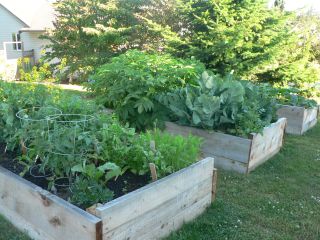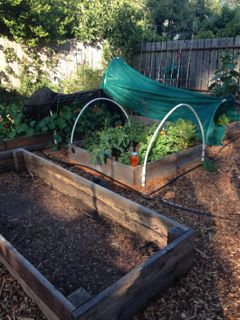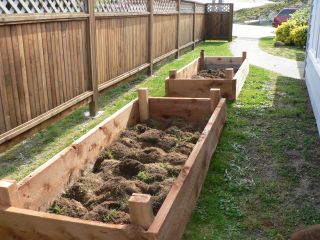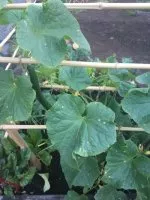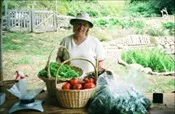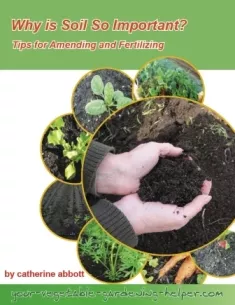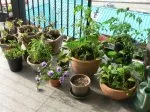Raised Bed Vegetable Gardening
Raised bed vegetable gardening is similar to growing in containers, just on a much larger scale.
The main difference is a raised bed will contain the soil on four sides with the bottom open so plant roots can grow deeper into the existing ground.
If you have poor, sandy, rocky, or wet soil the raised bed would be ideal.
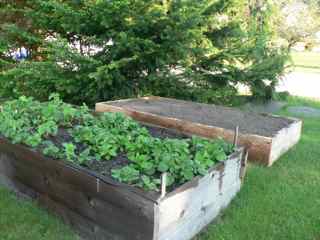 Raised beds in front yard work great.
Raised beds in front yard work great.For simple steps to planting a vegetable garden in raised beds check out my new ebook "Vegetable Garden Plans for Raised beds". I provide easy to follow diagrams and dates on when to plant your vegetables.
Benefits of raised bed vegetable gardening:
- soil warms up faster in the spring which can give you an earlier harvest
- soil is less compacted as you usually do not walk on the bed
- less bending as you plant, weed and water your garden
- can be a better use of space
- improves drainage
- gives your garden a clean and tidy look
- enhances your garden by adding structure
- can be of any height to suit your needs
- easy to trellis
Disadvantages for raised bed vegetable gardening:
- takes time and effort to build the beds
- some cost involved unless you can recycle materials existing in your yard
- beds may need more watering in hot weather
- more difficult to till using machinery
Making your raised bed:
When making a raised vegetable bed you can use a variety of materials to build it. A raised bed can be free standing in the sense of mounding your existing soil.
This works well if you already have good soil and you just want it to warm up quicker in the spring. Build raised beds can ve place almost anywhere in your garden layout.
Materials to use:
- Wood such as fir, poplar, cedar, plywood, landscape ties, logs can all be used. Some wood will rot quicker than others so be aware of this when deciding on the material.
- bricks
- cements blocks
- stone
- rocks
Width:
For me the maximum width of a bed is 4 feet, this allows me to reach to the center from both sides of the structure, making it easier to weed and harvest.
Length:
Beds can be any length or shape that works in your garden. I had an oddly configured backyard so made several triangular shaped beds to fit into the area.
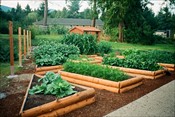 There are various types of materials that can be used. This is my first garden. Beds are made with cedar slabs.
There are various types of materials that can be used. This is my first garden. Beds are made with cedar slabs.Height:
Raised beds are a great way for older or disabled persons to garden as they can be any height that works best for you. You can even put a ledge around it to sit on.
If you are going to have several beds make sure you leave enough room between them to bring in your wheelbarrow or lawn mover if you are having grass between them.
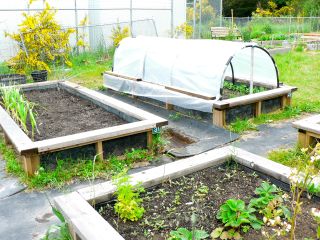 These raised beds are made so you can sit on the side to garden. Perfect for some who is disabled, or less mobile.
These raised beds are made so you can sit on the side to garden. Perfect for some who is disabled, or less mobile.Filling your raised bed:
You can purchase good topsoil but can also make your won. You will need to fill your bed with rich light soil such as equal parts of peat moss, compost and topsoil. One way is to remove some of the top soil in your pathways to add to your new beds.
- Break up or lightly till the area where you will place the bed. This will allow easier access for vegetable roots to grow deeper into the earth.
- add your new soil mix
- soak the bed with water to help settle the soil
- the soil should be 2-3 inches below the top of the bed.
Now what?
Start seeding your vegetables. Just one note: you will need to replenish the soil every year. Amending your soil by adding compost or aged manure is on of the bed ways to do this.
Return from Raised Bed Vegetable Gardening to Home Page
Recent Articles
-
Vegetable Gardening Frustrations: Lessons for a Better Harvest
Oct 29, 24 07:37 PM
Every vegetable gardener knows that while the rewards are sweet, the vegetable gardening frustrations can be a bit bitter. -
Small Space Vegetable Gardening
Sep 23, 24 05:06 PM
Small Space Vegetable Gardening - Tips for growing vegetables in small spaces. -
Why Fall Gardening?
Aug 16, 24 12:24 PM
Fall Gardening: A guide to a Bountiful Harvest.
